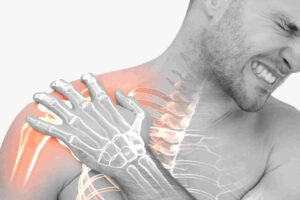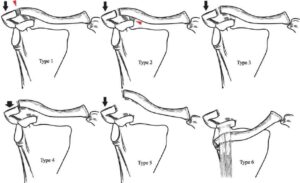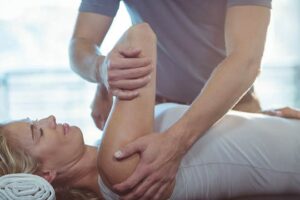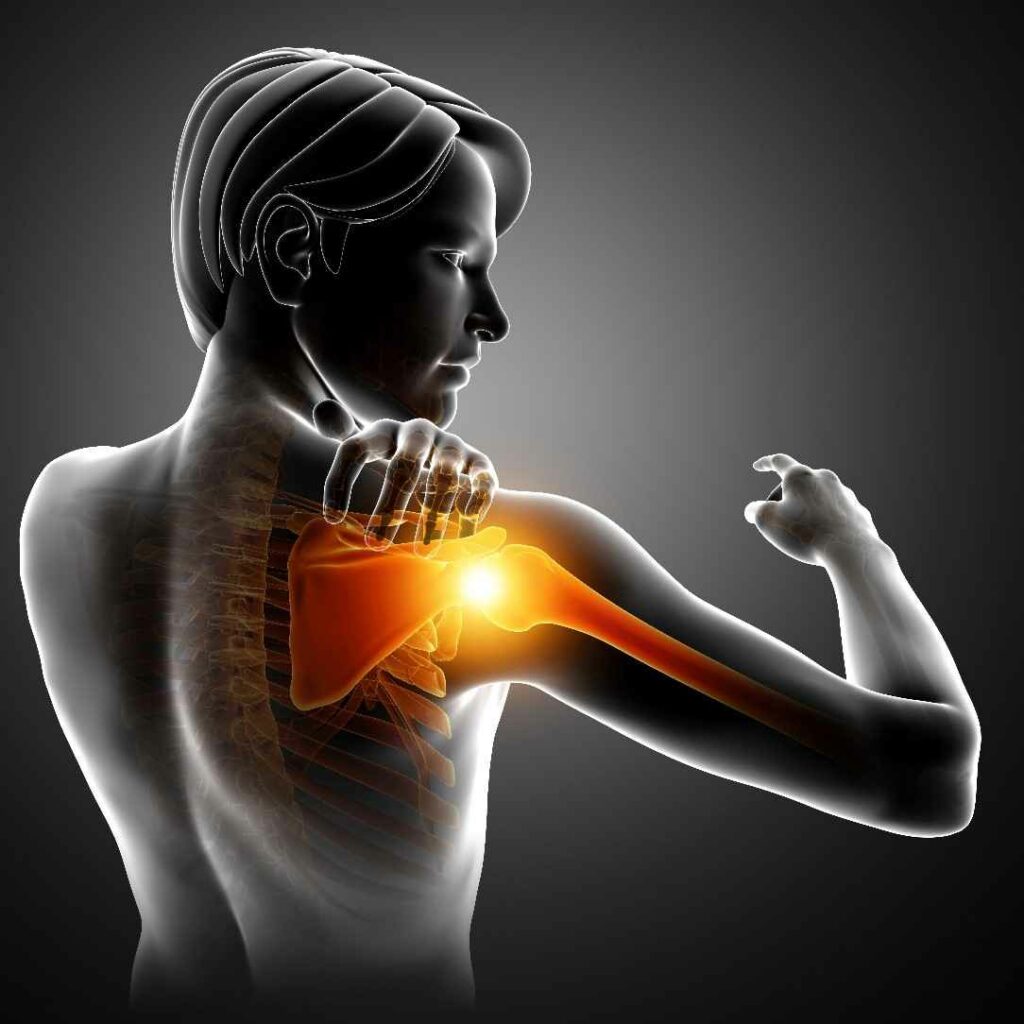If you are one of the millions of people who suffer from AC joint pain, you know how debilitating it can be. This condition can make it difficult to do everyday activities, and can even keep you from performing your job duties. In this guide, we will discuss the different treatment options available for AC joint pain. We will also provide tips on managing the pain and improving your quality of life.
Contents
What Is AC Joint Pain?

AC joint pain is a condition that affects the acromioclavicular (AC) joint, which is the junction where the collarbone meets the shoulder blade. This joint can become irritated and inflamed due to overuse or injury, causing pain and stiffness in the shoulder. There are several treatment options available for AC joint pain, ranging from rest and physical therapy to steroid injections or surgery.
Types Of Injuries For AC Joint Pain

Depending on which of the two ligaments hold your AC joint together, the coracoclavicular (CC) ligament and the ac joint are torn, as well as the severity of the injury, which can range from a slight twisting of the ligaments to a complete tear, there are different degrees of injury.
- Class I – Although they may be strained or sprained, your shoulder ligaments that surround your AC joint are not torn.
- Class II – The CC ligament sustains only minor damage, and the AC tendon is ripped.
- Class III – Your collar bone completely separates from your shoulder blade as a result of the ruptured AC and CC ligaments. The most serious AC joint injury is shoulder separation, which is also the most frequent.
- Class IV-VI – These are uncommon forms of AC joint damage. They range from displacement problems to total dislocation and are all rather debilitating.
How Is Acromioclavicular Joint Discomfort Diagnosed?
Pain in the acromioclavicular joint frequently develops without a known reason. Even if the shoulder hasn’t specifically been hurt or traumatized. It may appear owing to recurrent strain on the joint or as a result of “wear and tear” alterations in the joint.
Patients with suspected acromioclavicular joint injuries should have a standard shoulder examination, which includes measuring shoulder range of motion, feeling the shoulder’s bony structures for any step that could indicate an undetected fracture, and determining the patient’s neurovascular condition to check out brachial plexus damage (even though concomitant neurovascular damage is very rare in acromioclavicular joint injuries).
Treatment For AC Joint Pain
Resting from the motions and tasks that trigger your discomfort is the first step in treating it. Anti-inflammatory medicines and painkillers can also be helpful. We urge you to see a physiotherapist for an evaluation if the pain persists and does not away after a few weeks.
In order to help the pain subside, we may advise you to use a sling for a couple of days if the injury is fresh (within the previous week) and still very severe. We advise against using a sling for longer than a week. The severity of the advice will depend on the strain. While the damage heals, it’s crucial that your shoulder does not get stiff.
Your physiotherapist will use a range of hands-on treatments and exercises to relieve your pain and restore complete movement and strength of your arm after performing a thorough evaluation.
They want to return you to full functionality as soon as they can. Depending on the injury’s severity and how long you’ve been in pain, this typically takes 4-6 weeks.
Physiotherapy Treatment
 A physical therapist can not only identify the problem if you’ve had an overuse or traumatic injury to your AC joint, but they can also likely cure the dislocation without having to undergo surgery.
A physical therapist can not only identify the problem if you’ve had an overuse or traumatic injury to your AC joint, but they can also likely cure the dislocation without having to undergo surgery.
Your physical therapist can assist you in getting back to your regular activities in as little as two weeks, depending on the severity of your injury.
The Class 1 Treatment
Initial care should follow the POLICE protocol and include referral within 48 hours, protection, appropriate loading, ice, compression, and elevation. The sling is used to keep the shoulder elevated when at rest. Additionally helpful is taping the joint to provide support.
You must wear the sling until the discomfort subsides. For a kind I injury, the return to regular activities typically takes 2-4 weeks, for a type II injury, 4-6 weeks, and for a type III injury, 6-12 weeks. Intra-articular steroid injections may be recommended for people whose symptoms do not subside within this time frame.
As soon as the first-class injury’s symptoms start to improve, your physical therapist will design a programme that focuses on:
- Motion range
- Exercising your muscles
- Manual treatment
- Functional instruction
- Education of patients
The majority of patients can anticipate returning to their regular activities in two weeks.
The Class 2 Treatment
For class 2 acromioclavicular joint separation, immediate treatment options include:
- Putting on a sling for a week or two
- 48 to 72 hours of icing the wound
- Using an anti-inflammatory drug
After you’ve cleared your therapy, your physical therapist will plan your recovery by studying your previous therapies. Within two to three weeks, patients should be able to resume their normal activities.
The Class 3 Treatment
The same procedures used for grade 1 and 2 joint separations are used as immediate care for grade 3 AC joint damage.
Grade 3 ac joint injuries were historically advised to be treated surgically, but there is a growing understanding among medical practitioners that physical therapy is just as beneficial.
Gentle range-of-motion and isometric exercises will be encouraged by your physical therapist, who will then introduce a more structured physical therapy regimen. Physical therapy for grade 3 acromioclavicular joint separation may continue for up to 8 weeks or more depending on the patient’s condition.
Injury to the acromioclavicular joint in grades 4, 5, and 6 typically requires surgery.
Surgical Treatment
Depending on how severe it is, treating an AC joint injury will differ.
For class I and class II AC separations, nonoperative treatment is advised; however, type III AC separations are still up for debate due to the likelihood of early-onset degenerative joint disease. However, if the patient is young and physically active, or if a type III injury does not respond to conservative therapy, surgical intervention may be selected as it sometimes leads to superior functional outcomes. Surgical correction is highly advised for types IV and V.
There are numerous surgical procedures, however, the four most popular surgical alternatives are as follows:
- Fixing AC joints with hook-plates
- Transfer of the coracoacromial ligament
- Stabilization of the coracoclavicular gap
- Restoration of the coracoclavicular ligament.
Best Exercises For AC Joints
 Physical therapists are going to supervise and design your exercises.
Physical therapists are going to supervise and design your exercises.
Exercises for recovering AC joints could include:
- Neck turn
- sloping shoulders
- Neck exercises
- Squeeze the shoulder blades
- Reclining the shoulders
- Shoulder extension when standing
- Goalpost extension
It’s crucial to get expert counsel from a physical therapist before beginning any exercise regimen for AC joint rehabilitation.
Dos And Donts Of AC Joint Pain
Dos
- Move the shoulder as much as the discomfort will allow.
- Consult a physiotherapist if your discomfort has persisted for more than two weeks and is not getting better despite rest.
- Consider an ultrasonic injection if your pain is not going better with physiotherapy or if it’s getting worse.
Don’t
- Avoid fully ceasing all use of your shoulder as this may prevent it from getting better.
- Stop any activity above shoulder level if you are feeling pain for two weeks to see if the ache will go away.
- It won’t help to massage the region or to rub it!
How Long Will The Recovery Process Take?
Minor to severe AC joint sprains can heal in 2 to 6 weeks, depending on their severity. Longer lengths of rehabilitation are necessary for people with more serious acromioclavicular joint sprains that result in dislocation before they can function at their best again.
Conclusion
If you are experiencing pain or discomfort in your acromioclavicular joint, it is important to seek medical attention right away. Whether the injury is minor or severe, there are many different treatment options available, including physical therapy and surgery.
To get the best possible recovery outcome, it is important to work closely with a qualified healthcare professional and to follow their recommendations for rest, stretching, and exercise. With the right care and support, you can recover from AC joint pain and get back to your normal activities as soon as possible.
Physical Therapy help patients recover from pain. If you’re experiencing Back pain, Shoulder pain, Knee pain, Neck pain, Elbow pain, Hip pain, or Arthritis pain, a physical therapist at MantraCare can help: Book a physiotherapy session.


